.
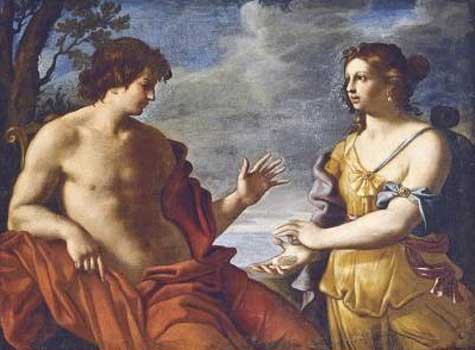
Apollo and the Cumaean Sibyl, Giovanni Domenico Cerrini, (1609-1681) after 1666, 102 x 135 cm
The Cumaean Sibyl was the priestess presiding over the Apollonian oracle at Cumae, a Greek colony located near Naples,Italy.
The word Sibyl comes (via Latin) from the ancient Greek word sibylla, meaning prophetess. There were many Sibyls in the ancient world, but because of the importance of the Cumaean Sibyl in the legends of early Rome, she became one of the most noted and famous, and was often simply referred to as The Sibyl.
In the art of Michelangelo shown to the right, and other painters her powerful presence overshadows every other Sibyl, even her younger and more beautiful sisters, such as the Delphic Sibyl.
There are various names for the Cumaean Sibyl: Amaltheia, Demophile, Deiphobe, Herophile, Taraxandra (in Vergil's Aeneid she is called Deiphobe--daughter of Glacus.
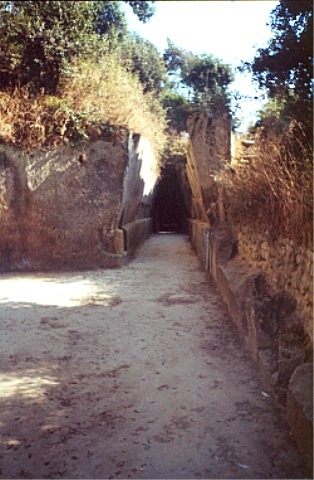
Entrance of the Sibyl grotto of Cumae [Source]
The cave at Cumae
The Sibyl was said to inhabit a cave with one hundred mouths, each of which had a voice [1] (http://www.thaliatook.com/sibyl.html) accessible by a still existing dromos. The Cave is a trapezoidal dromos or passage over 131 meters long running parallel to the side of the hill and cut out of the volcanic stone. The Cave of the Sibyl was rediscovered in May 1932 by Amedeo Maiuri.
It was said in some of the ancient poems that the whispers of the Sibyl would be heard for a thousand years, and some have said that they will resound and echo for all eternity.
Ancient Roman prophecies
The story of the acquisition of the Sibylline Books by Lucius Tarquinius Superbus, the semi-legendary last king of the Roman Kingdom, is one of the famous mythic elements of Roman history. Centuries ago, concurrent with the Fiftieth Olympiad and the Founding of the City of Rome, an old woman arrived incognita in Rome. She came to see King Tarquin. The Cumaean Sibyl offered nine books of prophecies to King Tarquin; and as the king declined to purchase them, owing to the exorbitant price she demanded, she burned three and offered the remaining six to Tarquin at the same stiff price, which he again refused, whereupon she burned three more and repeated her offer. Tarquin then relented and purchased the last three at the full original price (Dion. Halic. 4.62), (another version has the price doubling each time.) The books were thereafter kept in the Temple of Jupiter on the Capitoline Hill, Rome, to be consulted only on emergencies. The Sibylline Books were finally completely destroyed in 83 CE when the temple of Jove Capitolinus burned.
Medieval Christianity
In the Middle Ages both the Cumaean Sibyl and Vergil were considered prophets of the birth of Christ because the fourth of Vergil's Eclogues appears to contain a Messianic prophecy by the Sibyl, and this was seized on by early Christians as such - one reason why Dante later chose Vergil as his guide through the underworld and Michelangelo chose to feature the Cumaean Sibyl in the Sistine Chapel as prominently as the Old Testament prophets.
Constantine, the Christian emperor, in his first address to the assembly of Saints, interpreted the whole of the eclogue as a reference to the coming of Christ and quoted a long passage of the Sybilline Book (Book 8) containing an acrostic in which the initials from a series of verses read: Jesus Christ Son of God Saviour Cross.
Literature
The Cumaean Sibyl is featured in the works of, among others, Vergil (The Eclogues, Æneid), Ovid (Metamorphoses) and Petronius (Satyricon). The epigraph to T.S. Eliot's poem "The Waste Land" is a quote from the Satyricon where Trimalchio states that he saw the withered Sibyl in a hanging jar and that she wanted to die.
Stories recounted in Vergil's Æneid
The Cumaean Sibyl prophesized by “singing the fates” and writing on oak leaves. These would be arranged inside the entrance of her cave but, if the wind blew and scattered them, she would not help to reassemble the le aves to form the original prophesy again.
The Sibyl was a guide to the underworld (Hades,) the entry being at the nearby crater of Avernus. Aeneas employed her services before his descent to the lower world to visit his dead father Anchises, but she warned him the it was no light undertaking:
Trojan, Anchises' son, the descent of Avernus is easy.
All night long, all day, the doors of Hades stand open.
But to retrace the path, to come up to the sweet air of heaven,
That is labor indeed. (Aeneid 6.10.)
Stories recounted in Ovid's Metamorphoses
Although she was a mortal, the Sibyl lived about a thousand years. This came about when Apollo granted her a wish; she took up a handful of sand and asked to live for as many years as the grains of sand she held. But she didn't ask for enduring youth and Apollo allowed her body to wither away because the Sibyl did not consent to have sex. Her body grew smaller with age and eventually was kept in a jar (ampulla). Eventually only her voice was left. (Metamorphoses 14)
THE CUMAEAN SIBYL, Estelle M. Hurll
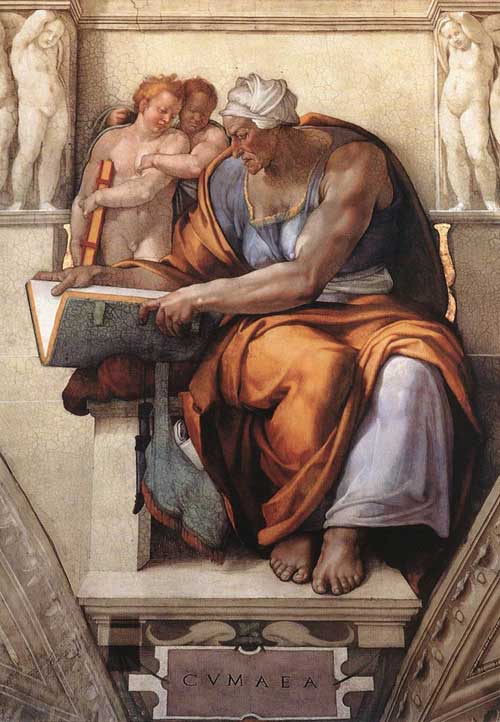
Michelangelo's rendering of the Cumaean Sibyl
Of all the sibyls, the one we hear most about is the Cumæan. The legend runs that, having asked a boon of Apollo, she gathered a handful of sand and said, "Grant me to see as many birthdays as there are sand grains in my hand." The wish was gratified, but unluckily she forgot to ask for enduring youth, so she was doomed to live a thousand years in a withered old age. Thus we always think of her as an old woman, as Michelangelo has represented her.
She is called the Cumæan sibyl because she is supposed to have lived in Cumæ, which was the oldest and one of the most important of the Greek colonies in Italy. Her real name, we are told, was Demos. She lived in a great cavern, where the people came to consult her, and her answers to their questions were regarded as oracles, or answers from the deities. She used to write on the leaves of trees the names and fates of different persons, arranging them in her cave to be read by her votaries. Sometimes the wind sweeping through the cavern scattered the leaves broadcast through the world.
The manner of consulting her is fully described by the Latin poet Virgil in the sixth book of the [68]Æneid. He tells how Æneas, arriving with his fellow voyagers at the town of Cumæ, immediately goes to the temple of Apollo,
"And seeks the cave of wondrous size,
The sibyl's dread retreat,
The sibyl, whom the Delian seer
Inspires to see the future clear,
And fills with frenzy's heat;
The grove they enter, and behold
Above their heads the roof of gold.
--------------------------------------------------------------------------------
"Within the mountain's hollow side,
A cavern stretches high and wide;
A hundred entries thither lead;
A hundred voices thence proceed,
Each uttering forth the sibyl's rede.
The sacred threshold now they trod:
'Pray for an answer! pray! the god,'
She cries, 'the god is nigh!'
"And as before the door in view
She stands, her visage pales its hue,
Her locks dishevelled fly,
Her breath comes thick, her wild heart glows.
Dilating as the madness grows,
Her form looks larger to the eye;
Unearthly peals her deep-toned cry,
As, breathing nearer and more near,
The god comes rushing on his seer."
Æneas now begs a favor of the sibyl. He has heard that here the path leads downward to the dead, and he desires to go thither to visit his father, Anchises. There are certain conditions to fulfil before setting forth, but when these are done the sibyl guides him on his way, and the journey is safely made.
Another legend of the Cumæan sibyl has to do with the Roman emperor Tarquin. The sibyl came to him one day with nine books of oracles, which she wished him to buy. The price was exorbitant, and the emperor refused her demand. She then went away, burned three of the books, and, returning with the remaining six, made the same demand. Again her offer was refused, and again she burned three books and returned, still requiring the original price for the three that were left. Tarquin now consulted the soothsayers, and, acting upon their advice, bought the books, which were found to contain directions concerning the religion and policy of Rome.
For many years they were held sacred, and were carefully preserved in the temple of Jupiter in the Capitol, under the care of official guardians. At length the temple was destroyed by fire, and the original sibylline books perished. In the following centuries they were replaced by scattered papers, collected from time to time in various parts of the empire, purporting to be the writings of the sibyl. These sibylline leaves, as they were called, contained passages supposed to be prophetic of the coming of Christ, and this is why the Cumæan sibyl is placed by Michelangelo among the prophets.
The sibyl is reading aloud from one of her books of oracles. The two little genii standing behind her shoulder, and listening with absorbed attention, hold another book, not yet unclasped, ready for her. She reads her prophecy with keen, searching eyes, and a manner that is almost stern. We can see in the large, strong features the determination of her character.
It is not a gentle face, and not pleasing, but it is full of meaning. We read there the record of the centuries which have passed over her head, bringing her the deep secrets of life. Yet the prophecies are still unfulfilled, and there is a look of unsatisfied longing in her wrinkled old face.
You will notice that the outlines of the Cumæan sibyl are drawn in an oval figure similar to that inclosing the Delphic sibyl. Here, however, the oval is of a more elongated form, and the left side is broken midway by the introduction of the book.
The old writer Pausanias, writing his "Description of Greece," in the second century, says that the people of Cumæ showed a small stone urn in the temple of Apollo containing the ashes of the sibyl. For many centuries her cavern was pointed out to travellers in a rock under the citadel of Cumæ. Finally the fortifications of the city were undermined, but to this day a subterranean passage in the rock on which they were built is still shown as the entrance to the sibyl's cave.

Prophets and Sibyls by Perugino, Details from a Fresco Perugia, Collegio del Cambio
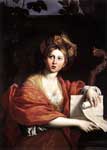
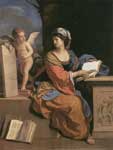

Ghent Altarpiece : The Sibyl of Cumae, Hubert van Eyck

Sibyl of Cumae, Andrea del Castagno

Lake Avernus Aeneas and the Cumaean Sibyl, Joseph Mallord William Turner
| Ancient Greece
Science, Technology , Medicine , Warfare, , Biographies , Life , Cities/Places/Maps , Arts , Literature , Philosophy ,Olympics, Mythology , History , Images Medieval Greece / Byzantine Empire Science, Technology, Arts, , Warfare , Literature, Biographies, Icons, History Modern Greece Cities, Islands, Regions, Fauna/Flora ,Biographies , History , Warfare, Science/Technology, Literature, Music , Arts , Film/Actors , Sport , Fashion --- |
From Wikipedia, All text is available under the terms of the GNU Free Documentation License

